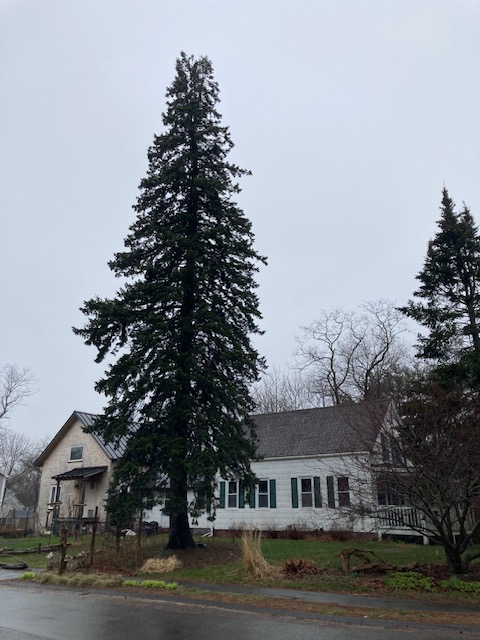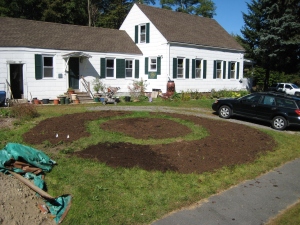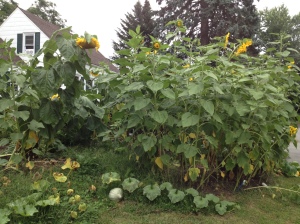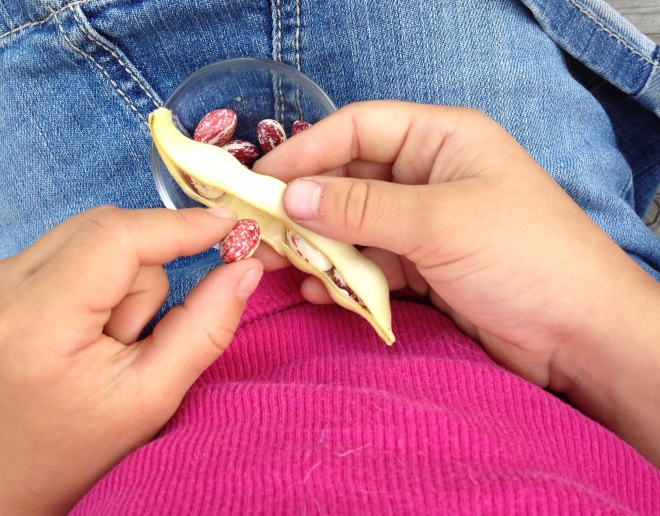15 driving debt
Posted: April 20, 2024 Filed under: Child Centered Activities, Money & Banking 2 CommentsMy daughter turned 15 last Sunday. On Tuesday she began Drivers Ed. On Wednesday we opened a checking account for her. She has asked about buying a car.
A few years ago, she and her friends bestowed upon me the title, “Funky Youth Pastor” which she assured me was a high honor. Given that, I hereinbelow give my sermon about turning 15, driving, and debt.
The word “mortgage” is derived from the Old French word “morgage”, which directly translates to “dead pledge”. This is not entirely morbid. In the early 1600s Sir Edward Coke, a barrister in England explained, “And it seemeth, that the cause why it is called mortgage is, for that it is doubtful whether the feoffor will pay at the day limited such sum or not: and if he doth not pay, then the land which is put in pledge upon condition for the payment of the money, is taken from him for ever, and so dead to him upon condition. And if he doth pay the money, then the pledge is dead as to the tenant.” In other words, a mortgage is “dead” when either the debt is paid or the payment fails.
Debt is not a death sentence but it carries a high cost. In fact, each of the monotheistic religions – Judaism, Christianity, and Muslim – have scripture which forbade interest.
The Quran, verse 275, says that interest – the payment upon debt – is forbidden:
“Those who consume interest cannot stand [on the Day of Resurrection] except as one stands who is being beaten by Satan into insanity. That is because they say, “Trade is [just] like interest.” But Allāh has permitted trade and has forbidden interest. So whoever has received an admonition from his Lord and desists may have what is past, and his affair rests with Allāh. But whoever returns [to dealing in interest or usury] – those are the companions of the Fire; they will abide eternally therein.”
In the Hebraic tradition, Deuteronomy 23:19-20, says that interest is not forbidden but it is restricted:
“Do not charge a fellow Israelite interest, whether on money or food or anything else that may earn interest. You may charge a foreigner interest, but not a fellow Israelite, so that the Lord your God may bless you in everything you put your hand to in the land you are entering to possess.”
Within the Christian tradition, in the early Middle Ages, it seems this scripture was taken to mean that Christians could not handle money but those of the Jewish faith could. And given that the Jewish people could neither own land, nor join a Guild to learn a trade, they became facile at handling money. But money was of Caesar’s realm, not God’s, and a schism was laid, then codified into law in 1745 when Pope Benedict issued his Vix Pervenit that condemned the practice of charging interest on loans as usury.
The words of the prophets have fallen on deaf ears. In January 2024 U.S. consumer debt – credit cards, students loans, auto loans, mortgages and payday loans – totaled $17.37 trillion dollars, and the median credit card interest rate is currently 24.37%. The gross federal debt of the United States has surpassed $34 trillion dollars. We are intoxicated with credit.
It was not always this way. In July of 1979 USA President Jimmy Carter gave his “Malaise” speech, speaking to the nation “…about a fundamental threat to American democracy…to worship self-indulgence and consumption.”
“It is a crisis that strikes at the very heart and soul and spirit of our national will. We can see this crisis in the growing doubt about the meaning of our own lives and in the loss of a unity of purpose for our nation. In a nation that was proud of hard work, strong families, close-knit communities, and our faith in God, too many of us now tend to worship self-indulgence and consumption. Human identity is no longer defined by what one does, but by what one owns. But we’ve discovered that owning things and consuming things does not satisfy our longing for meaning. We’ve learned that piling up material goods cannot fill the emptiness of lives which have no confidence or purpose.”
He had the decency to admit, “This is not a message of happiness or reassurance, but it is the truth and it is a warning.” No one wanted to hear that message. Jimmy Carter consistently ranks among the least respected of US Presidents and he lost in a landslide in the 1980 election.
Carter’s prophecy went ignored and twenty-one years later, the man from Kennebunkport, President George W. Bush would address the nation in September 2001 and encourage continued consumption.
Following the devastation of 9-11 he said, “And one of the great goals of this nation’s war is…to tell the traveling public: Get on board. Do your business around the country. Fly and enjoy America’s great destination spots. Get down to Disney World in Florida. Take your families and enjoy life, the way we want it to be enjoyed.”
My child, at the age of 18 you will be legally able to enter a contract and borrow money. We will then advise but no longer control your decisions. Certainly there is a car in your future and my goal now is to give you clarity to guide your decisions.
The auto website Edmunds reported in October 2023 that the average new car payment had reached an all-time high of $736 per month. The average cost of used cars was $29,328. As options and panache increase so too does the cost; always consider whether your purchase and obligations are sustainable. There is a wisdom in frugal simplicity.
And keep in mind what Ghandi said, “Live simply so that others may simply live.” This quote is available on a bumper sticker. Maybe put that on your first car?
Tall trees and high winds
Posted: April 12, 2024 Filed under: Farming off the Farm, Permaculture & Home Renovation 1 CommentThe Blue Spruce that towers over our farm house is at least 100 feet tall with a circumference of 92″. The tree is very likely 100 years old, a stately mature Picea pungens Englum.
According to the USDA, “…the root system of blue spruce is relatively shallow, even in mature trees. In spite of the shallow root system, blue spruce is decidedly windfirm.” “Windfirm” is not a defined term – as far as I can tell – and so that is a question of significance to our Art Farm.
The backyard of our 200-year old farm house was traditionally the dump for all waste, and having been overlooked, the invasive Norway Maple thrived. Because the Norway Maple is very fast growing its wood grain is long, not tight, and so it easily splinters in high winds. Several maples have sheared and fallen. Two years ago a smaller, 8” caliper maple, fell onto our above-ground pool. Luckily the pool survived.

This year a very large 14” caliper maple sheared and fell into our neighbor’s yard. Thankfully there was no damage. We gained firewood but the trend is clear.
The 2023-24 winter was one of the warmest, with the least snow, since 1940. What snow we did have came in late March and early April and those storms brought wet heavy snow with gusts up to 50 mph. The damage was considerable. More than 200,000 Mainers lost power in the first storm, and 350,000 in the latter.
The Portland Press Herald published these graphs, from the Climate Change Institute at the University of Maine, which clearly show an established trend over 80 years: winters are warmer and the snowpack is much less.

The data show facts that we already know from our own experience. As Bob Dylan sang, “You don’t need a weatherman to tell you which way the wind blows.” During these heavy snow storms, pine and spruce trees are especially at risk because the wet snow clumps on the needles and become like sails against the wind.
And so the USDA statement that “blue spruce is decidedly windfirm” is of particular concern here. On the one hand, the stately tree is healthy and vigorous. On the other hand, it is only 25′ from our house. It would be very painful to cut it down, but even harder if it fell onto our home. Hard decisions lie ahead.
Persephone returns
Posted: April 7, 2024 Filed under: Farming off the Farm, Little Green Thumbs 2 CommentsPersephone returns, and thoughts turn to Gaia and the garden.
For many years, we have grown several varieties of heirloom beans (none of which seem to be locally available). This is our beans’ story.
A few years back, during the spring term, I had the opportunity to teach English to refugees and immigrants. There was neither a curriculum nor textbook. I was given a classroom at the SoPo High School and told to figure it out. After a few classes I decided to focus on food – something universal – using children’s stories as a reader.
I brought our beans to the class and chose to read “Jack and the Bean Stalk.” Even though they did not speak English, they recognized the story; the single Mother from Venezuela nodded, smiled and whispered “Si, Juan y frijoles!” Another student, a young man from Angola – who walked 5 miles to and from each class, having walked north from Brazil, across the Darien Gap, to reach the USA southern border – this young man, not to be denied, nodded earnestly in recognition. Of note, the children’s story did not insult them; they craved the chance to learn.
Wikipedia contains an entry titled “Jack (hero)…Jack is an English hero and archetypal stock character appearing in multiple legends, fairy tales, and Nursery rhymes.” Fairy tales proved an effective cross cultural learning tool with pole beans central to one of the most famous of Jack stories.
Considering how nutrient-dense are beans it seems not coincidental they are central to an archetypal story. And beyond the archetype, they can manifest as daily nutrition in our diet. Frances Moore Lappe proselytized the protein-rich nutritional value of beans and her 1971 seminal book Diet for a Small Planet has been called, by the Smithsonian’s National Museum of American History, “one of the most influential political tracts of the times.”
As a protein source, beans are beneficial to the environment, whereas production of red meat generates substantial carbon dioxide, methane and nitrous oxide. Beans require minimal water and lower greenhouse gas emissions because they “fix nitrogen” by converting nitrogen from its molecular form (N2) in the atmosphere then converting into nitrogen compounds useful for other biochemical processes; the NH3 they produce is absorbed by the plant. The nitrogen fixing enriches the soil, decreasing the amount of fertilizer needed by the crop planted after them in the rotation. Soil fertility is increased as a result of having grown the beans.
The beans we grow came to us through Nance Klehm, a steward of the Earth working at the vanguard of art and the Earth. She has lectured at the Museum of Contemporary Art, the Hammer Museum in Los Angeles, the University of Cincinnati, and the Canadian Centre for Architecture in Montreal. She has taught at the University of California – Los Angeles, Northwestern University in Evanston, Illinois, and Dartington College in the United Kingdom, as well as for countless community groups worldwide. Her web site is: https://socialecologies.net/spontaneous-vegetation/.
As part of her work, Nance helped organize the Seed Temple, a seed bank located in Estancia, New Mexico, founded by Flordemayo, a Curandera Espiritu, or a healer of divine spirit. Flordemayo is one of the 13 Indigenous Grandmothers. https://www.grandmotherswisdom.org/ The grandmothers “…are committed to supporting all people reclaiming their relationship to Mother Earth, calling for a profound transformation in the heart, mind, and spirit. The Grandmothers Wisdom Project is an Earth-based community actively building a bridge to support the living legacy of ancient traditions that gives us deeper insight into the mystery of life and the importance of honoring the connection that exists among all beings, nature and the cosmos.”
Know your food
Know your farmer
Know your seeds’ provenance
About ten years sago, Nance asked us to grow the beans and then return a portion back to the seed bank; a seed bank need be a living library, and we were happy to help.
We currently grow eight varieties:
- Wild Goose
- Rwanda
- Appaloosa
- Deseronto Potato
- Beauty’s Way
- Good Mother Stollard
- Turkey Craw
- Corn Planter
2023 was a challenging year in our garden. From Georgia north to Maine there were virtually no stone fruits, a late deep freeze having killed the blossoms. We had no peaches, a mainstay from our orchard. Many gardeners commented on the challenges. In our garden a varmint devoured all of the sprouts, including our bean crop. I was slow to replant, and watched with growing fascination as many of the beans sprouted a second time. Having planted less than one cup, we still harvested several quarts – in the most challenging season on record.
On Wall Street the Masters of the Universe, the glassy-eyed bankers, Homo Economicus and the Prudent Person battle for yields of 1/10th of a percent. In our garden just outside the kitchen, Gaia – in her majestic repose – provided an annual yield of breathtaking proportions, which continues to feed my family and our friends. There is something profound here.
Great Mother, indeed !!
Crossing the Rubicon, crossing a cultural divide
Posted: March 31, 2024 Filed under: Art & Healing | Tags: art, exhibition, myth, mythology, spirituality 3 Comments
In 2000 I built, with Andy Rosen, a 25′ sculpture of a North Atlantic Right Whale. The sculpture was part of a collaborative exhibit, about our relationship to the rapidly warming Gulf of Maine, on display in two locations since then. The second exhibit recently came to an end, but as fortune blessed us, we have been able to donate the entire exhibit to the Wabanaki Public Health & Wellness Center in Bangor, Maine.
On the leap day, 29 February, I delivered the whale et al to the Wabanaki Public Health & Wellness Center. I was greeted by enthusiastic people, who welcomed our gift, and all of whom bore a similar resemblance. These were “people of the first light” members among the First Nations, and I powerfully realized that in crossing the Penobscot River I also crossed a cultural divide.
“Sea Change” within my/our culture was “other,” a puzzle, an odd fit. It had been well reviewed in the Sunday Press Herald and approximately 60,000 people experienced the exhibit. But we had a hard time getting people to embrace it, institutions especially. A robust PR campaign was promised, but in the end little was done to promote the exhibit. The board seemed to hold it at arms length while the administration neither recognized our donors, nor even acknowledged our “in kind donations.” One of our artists summed it up, “Our exhibit pushed some buttons that the museum was uncomfortable with….” One has to wonder.
We were invited to meet with a local ocean research institute to move the exhibit there, including an educational outreach, but their leaders rejected it, in part because of political issues; they directly said they could not take the whale because it touched upon the fisheries issue. Their major supporter is the fisheries industry. So our exhibit had run its course, its welcome worn out, and would have been hauled to the landfill.
To the Wabanaki it is a cherished asset, which they will use to help teach future generations (emphasis plural) about their link to the land. They welcomed my delivery not as plywood and tree trunk, not as wire and fabric, but a component of health and wellness. Their community has serious issues of addiction and mental health; in fact, alcohol, substance use and mental health disorders, suicide, violence, and behavior-related morbidity and mortality in American Indian and Alaska Native communities are disproportionately higher than the rest of the U.S. population. Our exhibit will be expanded into an immersive permanent exhibit in the Cafe of their Bangor center, showing the integration of life, the sustaining power of the Penobscot River, the grand web from Katahadin to Cashes Ledge, that all life is one.
What to my/our culture had become detritus is, to the Wabanaki, a most obvious opportunity. This has come to challenge me in a way reminiscent of paradox to Kierkegaard.
In the Oxford English Dictionary myth has two definitions. The first being “a traditional story, especially one concerning the early history of a people or explaining some natural or social phenomenon, and typically involving supernatural beings or events” with the second “a widely held but false belief or idea.” To my mind, in common parlance myth has become a pejorative term.
Carl Jung wrote, ““Everything that the modern mind cannot define it regards as insane.” Within our Western tradition of rationalism, dominated by monotheism, it is striking to note that one of our Great Men, the maven of rational insight and the material world, Sir Isaac Newton, led a secret life as a leading alchemist. He refused to publish his alchemical work – indeed, it was burned in a fire – perhaps for fear of scorn and rejection. The English Crown issued severe penalties for alchemy, including public hangings. Within our culture heretics have been burned at the stake, and witches sentenced to death.
Art-making predates agriculture, and thus predates civilization. Archetypes would seem to predate religion. Jung thought so, observing that organized religions had perfectly adapted the archetypes to their ritual stories. He wrote this not to denigrate religion, but, as a man of science, to pursue his “study of the soul.” The word archetype is derived from the Greek ἀρχῇ which is also, interestingly, the first noun [Ἐν ἀρχῇ ἦν ὁ Λόγος] of the “Book of Books,” the dominant sacred text within our Western tradition.
The word “archetype” first appeared in the English language during the 1500s, and conceptually relates to the Platonic forms, so I feel on solid ground considering them a priori and the religious narrative secondary. I am growing in certainty that archetypes may be the keyhole through which the light of consciousness shines, with myth providing the keys to unlock the “many rooms in my Father’s house.”
The act of making, to my mind, then is one means to manifest these truths.
Allow me to close with this story from the First Nations:
Whale witnessed the events that led to the settling of Turtle Island (North America) and has kept the records and knowledge of the Motherland alive. It is said that Mu (the Motherland) will rise again when the fire comes from the sky and lands in another ocean on Mother Earth. All of Earth’s children will have to unite and honor all ways and all races in order to survive.

Removing Obstacles
Posted: November 24, 2019 Filed under: Art & Healing, Gallery - Visual 1 Comment

Ganesha has become a comforting figure to me. He is the remover of obstacles and master of wisdom and knowledge. A beloved friend attended the festival of Ganesha in India. She brought with her, an item from our home and placed it on an altar during the festival. I’ve continued to find him in lots of places, or maybe it’s the other way around.
Since my last post, regrettably over a year ago, I have struggled with how to incorporate my surgical screws into some creative effort.
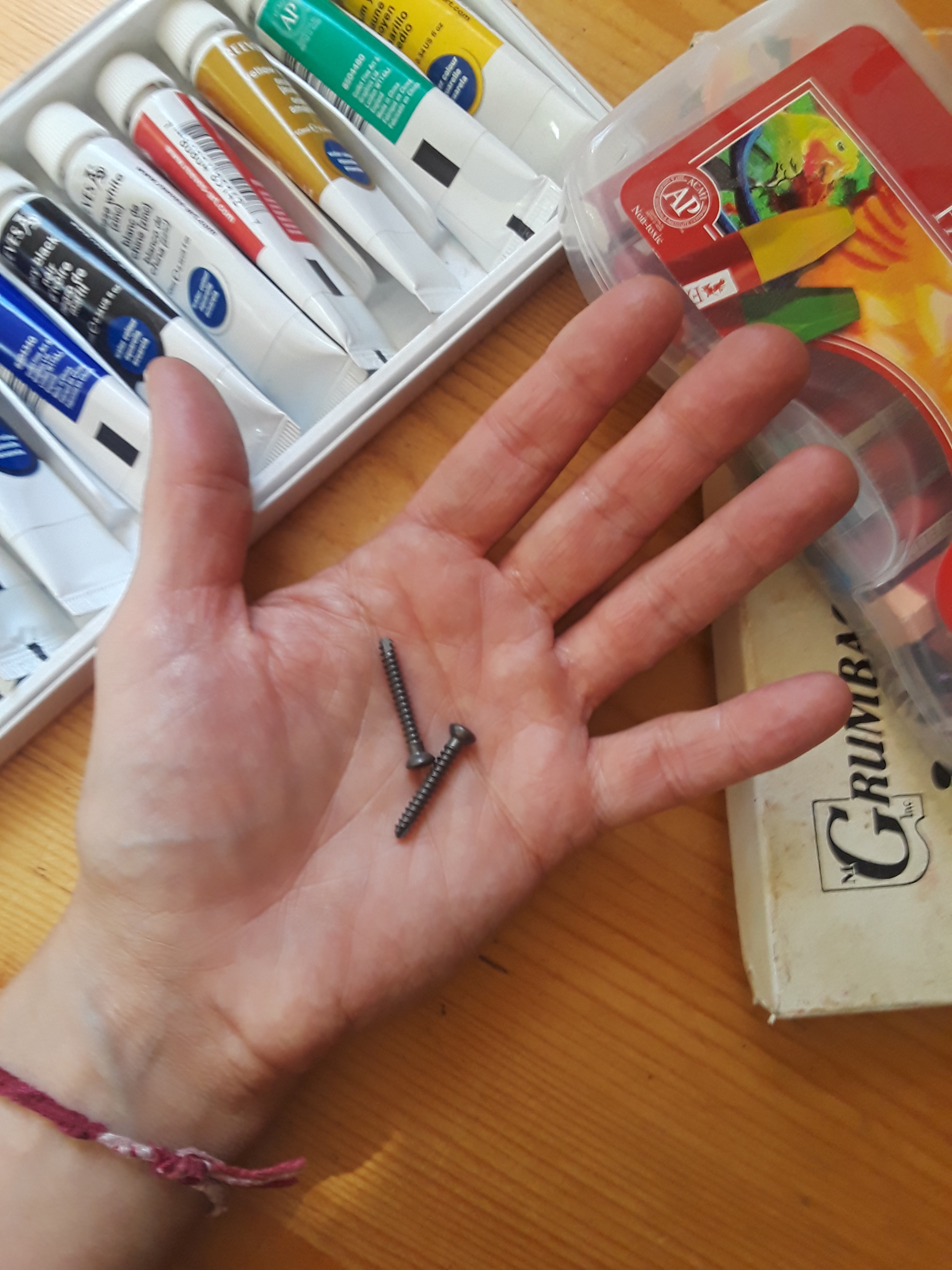
Recently, I’ve been experimenting with clay and simple sculpture materials to recreate my perception of Ganesha, holding symbols of personal obstacles.

To be continued…


Destruction/Creation
Posted: October 26, 2018 Filed under: Art & Healing 4 CommentsTwenty-five years and 5 surgeries later I’m still healing from an accident which changed my life. Two friends died in a car accident and I was spared. I walked away. I did not know that both of my feet were injured and continued to not know until 13 years later when arthritis and bone spurs brought intense pain when I walked.
A lot of life has happened in 25 years. I am married to an incredible partner and have 2 beautiful, strong-willed, compassionate and creative children. I have a fulfilling career where I try to connect with and support others on their paths to healing and recovery.
Surgery 3 weeks ago removed 2 screws which have been keeping my left, big toe joint from bending. I feel compelled to use these objects in some way that transforms them from what they were into something new. I’m still trying to make sense of what happened so long ago and here is another opportunity to try.

Redefining & Reframing What it Means to be SAFE
Posted: July 29, 2016 Filed under: Art & Healing 2 CommentsWhat is safe, what is unsafe?
What does safety look like, feel like, sound like?
How do you know when you are safe?
How do you know when you are unsafe?
I ponder these questions as I go deeper into my work with little ones, grown ones, and the ones in-between. With dialog and art media we explore stories of struggle, threats to safety, resilience, set-backs, side-steps and efforts to move forward.
I created these sculptures from the same foil/tape method as used with the starfish and giraffe series. I will complete with acrylic paints once they are ready. For me, the shells represent a familiar, innocent and straight-forward form of safe space and protection. Often, in my clients’ experiences, there is no familiar, innocent or direct connection to this most basic need.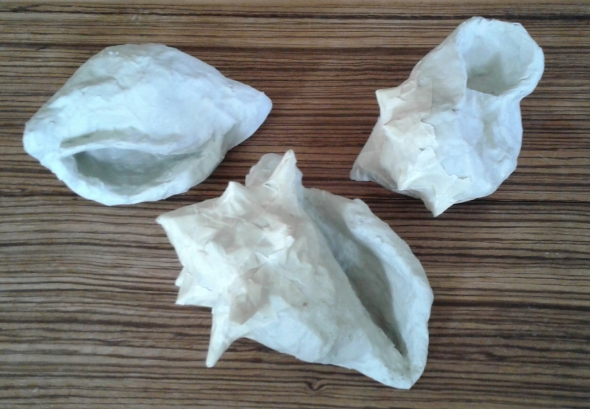
Starfish Galaxy
Posted: November 23, 2015 Filed under: Art & Healing 3 Comments Continuing to explore the experience of resilience and survival and what it looks like through metaphor and sculpture. Materials include aluminum foil, masking tape, acrylic and puff paints.
Continuing to explore the experience of resilience and survival and what it looks like through metaphor and sculpture. Materials include aluminum foil, masking tape, acrylic and puff paints.
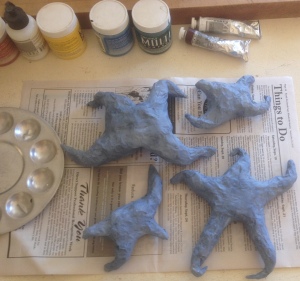
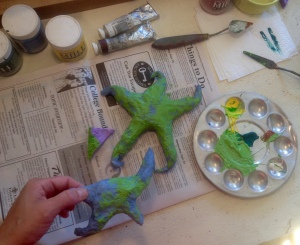

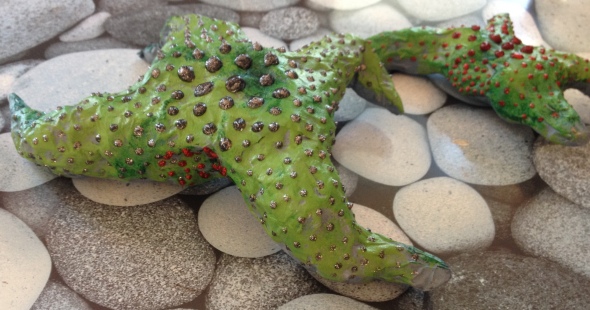

Getting the Lead Out (phytoremediation)
Posted: November 6, 2015 Filed under: Farming off the Farm, Permaculture & Home Renovation 1 CommentWhen we purchased our home, it was the land I valued as the key asset. Our first soil test brought the stunning news that lead in the soil averaged 480 parts per million, a level classified as “move garden to uncontaminated soil.” We got busy researching, and learned that Helianthus annus, the common sunflower, will draw the lead out of the soil.
With that shot of enthusiasm we got to work amending our land. In the autumn of 2013 we sheet mulched a large space in our sun-drenched front yard; we call this the mandala garden. On top of a thick layer of cardboard, we piled rock dust, aged manure, chopped leaves and perennials, and clean top soil: the pile was about 14″ high.
By the spring of 2014 we tested the soil again and this area – far enough away from our house to be out of reach of lead paint chips – showed a level of 280; better but still too high to grow leafy or root vegetables.
We sowed many seeds of Titan, Russian, and Red Pilsen sunflowers and let nature run its course. When we cut down all the sunflowers we disposed of them; you don’t want to compost those!
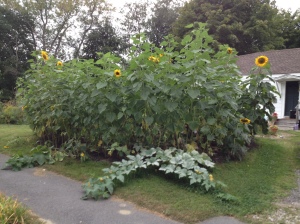
This spring our soil test showed 215 ppm, which is classified as a “slight” contamination but still is a major step forward. We continue to add compost, but we grew fruiting vegetables this summer.
And some sunflowers just for good measure.
Seed Saving
Posted: October 17, 2015 Filed under: Child Centered Activities, Farming off the Farm, In the Kitchen 3 CommentsThis year we grew Good Mother Stallard pole beans for the Seed Temple in Estancia, New Mexico <followthegoldenpath.org>. Our first time growing pole beans, I wasn’t sure how to dry them. While I researched, Ella walked into the garden, plucked from the vine one dried pod, pulled it apart, and…VOILA!…green beans had turned a gorgeous mottled red. Exquisite, fascinating, and a great shared lesson in seed saving.
We planted ten seeds and now have ten x ten x…an abundant cache to send back, to share with friends, and to sow next season.


